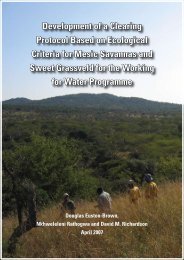Metsi Consultants - DWA Home Page
Metsi Consultants - DWA Home Page
Metsi Consultants - DWA Home Page
You also want an ePaper? Increase the reach of your titles
YUMPU automatically turns print PDFs into web optimized ePapers that Google loves.
12.2.2 Social Reaches and Villages<br />
Report No 678-F-001<br />
METSI CONSULTANTS: SUMMARY OF MAIN FINDINGS FOR PHASE 1 DEVELOPMENT<br />
The social reaches used in the IFR study are listed in Section 3. For the monitoring programme for Phases 1 and<br />
2 combined it was proposed that some of the eight river reaches be combined and the total number of social<br />
responses required be reduced. The wool sheds and clinics sampled should remain those used in the IFR study<br />
(Section 3).<br />
A mitigation and compensation programme which deals effectively with negative changes brought about by<br />
reduced river flows will have to have its own monitoring programme to quantify resource use and the actual<br />
amounts of resource reduction. This monitoring would effectively cover the same issues as a social monitoring<br />
programme with an added emphasis on those issues of most importance from the perspectives of mitigation and<br />
compensation. This approach is used below in determining the required monitoring activities.<br />
12.3. MAIN FEATURES OF THE IFR MONITORING PROGRAMME<br />
Three tiers of monitoring are recommended for the monitoring programme, viz.:<br />
pre-construction, baseline data collection;<br />
post-construction, release-specific data collection;<br />
post-construction, long-term routine monitoring.<br />
Summaries of the activities recommended in each tier are provided in Tables 12.1, 12.2 and 12.3, respectively.<br />
12.3.1 Pre-Construction: Baseline Data Collection<br />
For the most part the data collected during the IFR study are adequate as a baseline against which to assess<br />
flow-related changes in the study rivers. However, in some instances additional data collection has been<br />
recommended. The aims of this baseline data collection would be to collect:<br />
additional biophysical data that have been identified as being necessary to address knowledge gaps and<br />
to be able to distinguish between future flow-related changes in the rivers and other changes;<br />
data required to address the statistical aspects of data collection, such as the minimum number of<br />
samples required.<br />
12.3.2 Post Construction: Release-Specific Data Collection (Biophysical Only)<br />
The release-specific data collection should be confined to high flow events. The aims of the release-specific data<br />
collection would be to collect data that would allow an assessment of whether or not the rivers are responding to<br />
different components of the flow regime in the ways predicted. For instance, the fish specialist stated that withinyear<br />
high flows would provide cues for fish passage or spawning. Thus, release-specific data collection would aim<br />
at determining if fish spawning and migration did in fact occur in response to the release of such a high flow.<br />
Because of the purpose of the release-specific monitoring, it is envisaged that only biophysical data would be<br />
collected during this stage of the monitoring programme.<br />
The data from the release-specific collection activities would be used to fine-tune IFR releases, and refine<br />
predictions of future condition, if necessary.<br />
Since the sites closest to the LHWP dams would both be most affected by the flow changes, those sites should<br />
form the focus of the release-specific monitoring.<br />
68

















